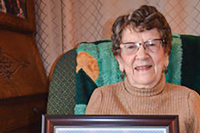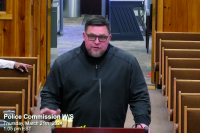Breathing life into the Museum that Runs
A few steps past the door at Maggie Valley’s Wheels Through Time museum, and the characteristic, unmistakable scent of a mechanic’s workshop wafts out – a heady mix of grease, motor oil, gasoline and rubber worn down by open roads.
With the vast and impressive array of motorcycles and memorabilia on display in the museum — both ancient and modern, rusted and restored — it would be easy to think that it is the perfume of these dormant machines’ pasts, reminders of their greatness in battle, their glory on the track.
But meeting Dale Walksler, the museum’s proprietor, curator and greatest fan, will prove otherwise. To him, this is a living museum. It is hard to walk more than a few yards with him before he stops to crank up one bike or another and tell its story, and he knows them all. To Walksler, the stories seem to be almost as valuable as the motorcycles themselves.
“It’s all about the story and the history,” he says. “I don’t go out and chase any old motorcycle. It has to have a story.”
And all of them do. Walking through the museum, which stretches over two floors and features special exhibits, vintage racers, military motorcycles, stunt bikes, a plethora of other machines and the accessories and memorabilia that accompany them, Walksler points out one of his newest acquisitions: a strange, 1916 Harley Davidson contraption that is driven from the sidecar.
“I’ve found nothing about it,” he says enthusiastically, but he’s already got a trip planned to the Harley archives in Milwaukee to see what he can dig up. That, he says, is one of the key features of what he does.
Related Items
“Research, lots of research,” is how he says he’s gotten to know the life stories of the bikes that call the museum home, and some are the most storied motorcycles this country has produced. The knowledge that is the prize for all that research, Walksler shares freely with anyone who happens to be around. A museum patron passes, asking about a particular bike in the back corner of the museum, and Walksler’s face is alight.
“That particular motorcycle was ridden by the Jack Pine champion,” he begins, before regaling the man and his wife with the story of the bike’s win and its rider’s own history, before quickly rattling off the answers to a few more obscure questions about the history of Harley Davidson shifting.
A tale behind each bike
Walksler is a compact man, his tawny hair and goatee shot through with grey, who walks with purpose and talks with animation, especially when the subject is motorcycles. His knowledge is encyclopedic, though not dry, and he has the delivery of a practiced showman — a mix of enthusiasm and bravado, information and entertainment.
Passing by another couple in motorcycle gear, he stops mid-sentence to thank them for stopping by. They’re from New Hampshire, and they’re riding their way back home.
“Would you like to see the rarest motorcycle in the world?” he asks slyly, and the New Hampshirans, of course, oblige. Leading the way, he begins telling the story of the Traub, a mysterious, one-of-a-kind motorcycle about which very little is known, apart from the fact that it was found in a brick wall by a Chicago fireman in 1967.
Walksler stops next to an old, reddish-orange bike with ‘Traub’ emblazoned on the side in stylized script and entertains his audience with the tale of how he acquired the bike from fellow collector Richard Morris. Before that, he says, it passed through the hands of both Steve McQueen and his stuntman, Bud Ekins, also an aficionado.
“Would you like to see it run?” he asks, almost rhetorically, and as he cranks the ancient machine, even more visitors materialize, drawn by the shuddering, spitting, deep-bass call of the Traub that bounces and echoes, ear-splittingly amplified, off the high warehouse ceilings. The audience is growing.
The Traub is clearly one of the crown jewels in Walksler’s collection. Some people, he says proudly, come just to see it. And whether or not this is true, his excitement makes it believable, and even a cursory inquiry will reveal that it is, in fact, a remarkably rare piece of antiquity.
But as he leads the impromptu tour group around the floor, his manner is surprisingly low on favoritism. The consummate collector, he is enamored of his entire compendium equally, and he’s been adding to it for most of his life.
“The first bike I ever owned was a 1957 Harley,” he says. “It was $25.” When he bought a bike off another high schooler for roughly the same price, and promptly sold one of its parts for $125, he was sold.
A shop followed in 1970, and a Harley dealership in southern Illinois sprung up a few years later. Along the way, Walksler was meticulously building his collection, anticipating the day he would share it with the public at large.
“Being selective is really important,” he says. He judges his acquisitions by three criteria: its rareness and desirability, make — he collects only American machines – and the story behind the piece.
“And then I’ve still got to make it run,” he says, grinning as he perches reading glasses atop his head and sets down a stack of photos sent to him by one of many hopeful sellers. And indeed, most of the museum’s specimens do at least crank, even the most geriatric and unlikely candidates.
In fact, he just completed the inaugural Motorcycle Cannonball — a jaunt across the nation raced exclusively on bikes that are more than 95 years old — on a 1915 Harley Davidson from the collection.
Unrivaled passion
Wheels Through Time, in its first incarnation, began in 1993 in Mount Vernon, Illinois, where it enjoyed a 13-year run before Walksler packed it in and shipped off to Maggie Valley, where he set up shop because, as he points out, it’s where the motorcyclists already come.
“It’s a known dot on the map,” he says, launching into an anecdote to illustrate the point.
“My brother was in a meeting, and he says, ‘my little brother is moving to Maggie Valley,’ and three people — this is in Chicago — said, ‘Hey, I know where that is!’”
Since his arrival in 2006, Walksler hasn’t exactly enjoyed an untarnished relationship with the community. Frustration with what Walksler perceives as a lack of reverence for his museum by locals even prompted him to consider another move last year.
But back on the floor, he has only words and eyes for the collection that has sent him into relative prominence in the motorcycle community.
A member of the little group — an elderly man in a denim shirt, jeans held up with black suspenders, worn riding boots an a red cap that identifies him as the St. Louis Bevo Beer Packaging Supervisor — pipes up to ask if there are any flat-track bikes. His name is Ed Gahn, and he is a 71-year-old flat-track racing veteran himself.
“I got to see hospitals all over the Midwest,” he quips, laughing as he folds his arms across his chest.
Of course, replies Walksler. He quickly drums up three or four names that Gahn recognizes, and when a particularly legendary and difficult bike — Leaping Lena — is mentioned, Walksler bids the group to follow him, for that same bike, he says, is in the back corner, and both men have ridden it.
And so went the morning — a spontaneous show featuring his most treasured highlights and history of American motorcycle culture, with Walksler acting as emcee, ringmaster and professor. He summons a battery of dates and figures, names and stories, developments and disasters with keen alacrity, in his element among his beloved machines, exuding charisma as he coaxes half a dozen motorcycles to life for the benefit of his elated spectators.
But not everyone is as pleased with Walksler, or his efforts locally. The enmity between him and some in the local community is no secret, and he isn’t timid about sharing his disdain for what he perceives as a less-than-welcoming reception he and his museum have garnered from some tourism and business leaders.
“I’m not the kind of person who’s going to change my focus and life for the people who don’t get it,” he says, adding that he feels no support from the local tourism entities or local government. “I honestly think a lot of them think ‘I guess we already get enough of them [motorcyclists] through here, so that’ll do.’”
When asked why he chose to keep the museum in Maggie Valley despite conflicts within the community, he answered that “the real reason is that I’ve made as many adjustments as I’m willing to make.”
As far as an end to the hostility is concerned, Walksler says he is open to better relationships locally, but seems less inclined to proactive cultivation.
“My door is open all the time,” he says.
But despite his personal quarrels on the local scene, his offerings to those inside and out of the motorcycle community are a unique, well-curated collection that reflects the passion and eagerness of its owner.
“This isn’t a motorcycle museum,” he says, “it’s a museum of American history and culture.”









